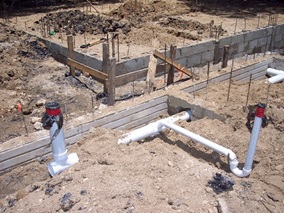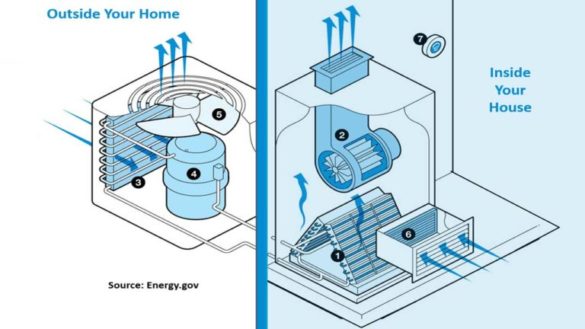The article down below in relation to Understanding Your Home's Plumbing Anatomy is rather enjoyable. Give it a go and make your own conclusions.

Comprehending how your home's pipes system works is vital for every homeowner. From delivering clean water for alcohol consumption, food preparation, and showering to safely getting rid of wastewater, a well-maintained pipes system is critical for your family members's wellness and convenience. In this thorough overview, we'll check out the complex network that comprises your home's plumbing and deal pointers on upkeep, upgrades, and taking care of usual problems.
Introduction
Your home's pipes system is greater than just a network of pipelines; it's a complex system that ensures you have accessibility to tidy water and efficient wastewater removal. Recognizing its parts and exactly how they collaborate can help you protect against pricey repair work and guarantee everything runs efficiently.
Fundamental Parts of a Pipes System
Pipes and Tubes
At the heart of your plumbing system are the pipes and tubes that carry water throughout your home. These can be made from various products such as copper, PVC, or PEX, each with its benefits in terms of resilience and cost-effectiveness.
Components: Sinks, Toilets, Showers, and so on.
Fixtures like sinks, bathrooms, showers, and bath tubs are where water is utilized in your house. Comprehending how these fixtures attach to the plumbing system assists in detecting issues and planning upgrades.
Valves and Shut-off Factors
Valves manage the circulation of water in your plumbing system. Shut-off valves are crucial during emergency situations or when you need to make repair work, permitting you to isolate parts of the system without interrupting water flow to the entire home.
Water System
Main Water Line
The primary water line attaches your home to the municipal water system or a private well. It's where water enters your home and is distributed to different components.
Water Meter and Stress Regulator
The water meter steps your water use, while a pressure regulatory authority makes certain that water streams at a secure stress throughout your home's plumbing system, avoiding damage to pipes and components.
Cold Water vs. Warm water Lines
Understanding the distinction in between cold water lines, which provide water directly from the primary, and warm water lines, which bring heated water from the hot water heater, helps in troubleshooting and preparing for upgrades.
Water drainage System
Drain Pipes and Traps
Drain pipelines carry wastewater away from sinks, showers, and bathrooms to the sewage system or septic tank. Traps protect against sewer gases from entering your home and likewise catch particles that can cause blockages.
Air flow Pipelines
Air flow pipes allow air into the drain system, protecting against suction that could slow down drain and trigger catches to vacant. Correct air flow is vital for preserving the honesty of your pipes system.
Value of Appropriate Drain
Making sure correct water drainage protects against back-ups and water damage. Frequently cleaning up drains and maintaining traps can prevent pricey fixings and expand the life of your pipes system.
Water Heating Unit
Types of Water Heaters
Water heaters can be tankless or typical tank-style. Tankless heating systems warm water on demand, while tanks save warmed water for prompt usage.
How Water Heaters Attach to the Pipes System
Understanding just how hot water heater attach to both the cold water supply and hot water circulation lines assists in diagnosing concerns like inadequate hot water or leaks.
Upkeep Tips for Water Heaters
On a regular basis flushing your hot water heater to remove debris, inspecting the temperature level settings, and checking for leaks can expand its lifespan and boost energy performance.
Common Plumbing Issues
Leakages and Their Causes
Leakages can take place as a result of maturing pipelines, loose fittings, or high water pressure. Resolving leaks quickly protects against water damage and mold and mildew development.
Blockages and Obstructions
Clogs in drains and commodes are typically brought on by flushing non-flushable things or an accumulation of grease and hair. Utilizing drainpipe screens and bearing in mind what drops your drains can stop obstructions.
Signs of Pipes Troubles to Watch For
Low tide stress, slow drains, foul odors, or unusually high water expenses are indicators of potential pipes troubles that should be resolved quickly.
Pipes Upkeep Tips
Regular Assessments and Checks
Set up annual pipes assessments to capture issues early. Try to find indicators of leaks, rust, or mineral build-up in faucets and showerheads.
Do It Yourself Upkeep Tasks
Simple tasks like cleansing tap aerators, looking for toilet leakages making use of dye tablets, or protecting revealed pipelines in cold climates can stop significant plumbing issues.
When to Call an Expert Plumbing Technician
Know when a pipes issue needs expert experience. Attempting complex repair work without appropriate understanding can lead to more damage and higher repair work expenses.
Upgrading Your Plumbing System
Factors for Updating
Updating to water-efficient components or changing old pipelines can enhance water top quality, lower water bills, and increase the value of your home.
Modern Plumbing Technologies and Their Benefits
Discover modern technologies like clever leak detectors, water-saving toilets, and energy-efficient water heaters that can save money and minimize ecological effect.
Cost Considerations and ROI
Determine the in advance expenses versus lasting savings when taking into consideration plumbing upgrades. Lots of upgrades spend for themselves with reduced energy expenses and less repair services.
Ecological Influence and Conservation
Water-Saving Components and Appliances
Mounting low-flow faucets, showerheads, and commodes can substantially reduce water use without sacrificing efficiency.
Tips for Reducing Water Use
Simple practices like fixing leaks without delay, taking shorter showers, and running full tons of laundry and dishes can save water and lower your utility expenses.
Eco-Friendly Pipes Options
Consider lasting plumbing products like bamboo for floor covering, which is durable and green, or recycled glass for kitchen counters.
Emergency situation Readiness
Actions to Take Throughout a Pipes Emergency
Know where your shut-off valves lie and just how to shut off the water system in case of a ruptured pipeline or significant leakage.
Relevance of Having Emergency Situation Contacts Convenient
Keep contact info for local plumbers or emergency situation services conveniently available for fast reaction throughout a pipes crisis.
Do It Yourself Emergency Fixes (When Relevant).
Short-term fixes like utilizing duct tape to spot a leaking pipe or placing a container under a dripping tap can reduce damages until a specialist plumbing technician arrives.
Verdict.
Understanding the makeup of your home's plumbing system equips you to maintain it successfully, saving time and money on fixings. By complying with normal maintenance regimens and remaining informed regarding contemporary plumbing modern technologies, you can ensure your pipes system operates effectively for years to come.
HOW YOUR PLUMBING SYSTEM WORKS
Which Pipes Do What?
Blue lines = fresh water supply entering the building
Red lines = hot water supply entering the building
Grey lines = pipes carrying waste away from the building and venting pipes carrying gases away from the building (through the roof)
YOUR MAIN PLUMBING SYSTEMS
There are two main plumbing systems that support your home s basic plumbing needs one that brings clean water into your home, and one that sends dirty water away from your home. Connected to the toilet, bath, shower, and other faucets in your home, these two systems keep your water flowing in the right directions.
ACCESSING FRESH WATER
Fresh and clean water is brought into your home through the main water supply line . Filtered through one pipe, this water is pressured to flow into the various fixtures in your home at any given time.
This water can be sourced from a well located on your property, a pond or river (mostly cottages), or, as in most cases, from the city s municipal water treatment centre. However, it is important to note that water that is untreated, such as the water siphoned from ponds or rivers, may not be safe to drink. Personal water supplies always need to be treated for hardness and contaminants before consumed.
MUNICIPAL WATER SUPPLIES
Improve taste and odour
Remove sediment
Eliminate hardness
Reduce chlorine
COLD WATER SUPPLY VS. HOT WATER SUPPLY
Cold water flows into your home or building through the service line, which then distributes hot or cold water to your fixtures. This line is most commonly run through a central column that runs floor to floor. Hot water runs in short and straight pipes as the longer the pipeline, the more heat that will be lost in the transfer. Having shorter pipes also allows residents to access hot water more quickly.
WASTE WATER SYSTEM
Your wastewater system is divided into two parts pipes that send wastewater away from your home and venting pipes that send sewer gas away from your home. Sewage water travels through pipes that flush the water and waste towards local sewers that are operated and managed by your city or town. Most sewer systems rely on gravity to move the wastewater to where it needs to go.
The further away from your toilet or sink, the larger wastewater pipes become. This allows for waste to be disposed of from various parts of your home or business at once without pipe blockages. The angle and flow of these pipes are also essential for keeping your waste pipes clear of build up.
https://harrisplumbing.ca/how-your-home-plumbing-system-works/

HOW YOUR PLUMBING SYSTEM WORKS
Which Pipes Do What?
YOUR MAIN PLUMBING SYSTEMS
There are two main plumbing systems that support your home s basic plumbing needs one that brings clean water into your home, and one that sends dirty water away from your home. Connected to the toilet, bath, shower, and other faucets in your home, these two systems keep your water flowing in the right directions.
ACCESSING FRESH WATER
Fresh and clean water is brought into your home through the main water supply line . Filtered through one pipe, this water is pressured to flow into the various fixtures in your home at any given time.
This water can be sourced from a well located on your property, a pond or river (mostly cottages), or, as in most cases, from the city s municipal water treatment centre. However, it is important to note that water that is untreated, such as the water siphoned from ponds or rivers, may not be safe to drink. Personal water supplies always need to be treated for hardness and contaminants before consumed.
MUNICIPAL WATER SUPPLIES
COLD WATER SUPPLY VS. HOT WATER SUPPLY
Cold water flows into your home or building through the service line, which then distributes hot or cold water to your fixtures. This line is most commonly run through a central column that runs floor to floor. Hot water runs in short and straight pipes as the longer the pipeline, the more heat that will be lost in the transfer. Having shorter pipes also allows residents to access hot water more quickly.
WASTE WATER SYSTEM
Your wastewater system is divided into two parts pipes that send wastewater away from your home and venting pipes that send sewer gas away from your home. Sewage water travels through pipes that flush the water and waste towards local sewers that are operated and managed by your city or town. Most sewer systems rely on gravity to move the wastewater to where it needs to go.
The further away from your toilet or sink, the larger wastewater pipes become. This allows for waste to be disposed of from various parts of your home or business at once without pipe blockages. The angle and flow of these pipes are also essential for keeping your waste pipes clear of build up.
https://harrisplumbing.ca/how-your-home-plumbing-system-works/
Hopefully you enjoyed reading our section about Plumbing Installation 101: All You Need to Know. Thank you for taking a few minutes to browse our post. Enjoyed our content? Please quickly share it. Help another person discover it. I am grateful for your time. Don't hesitate to check our site back soon.
Maintenance Sign-Up